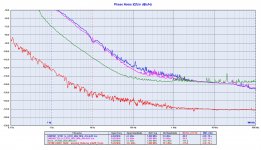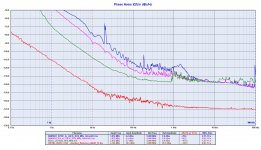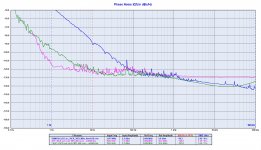Well its very much likely much better than totaldac and a step behind MSB.
No clue how your diy ad1865 performs but Naim CD3 from 1995 or thereabout is state of the art?
The beauty of measurements they dont lie but people do.
Again, please read carefully:
"unless my Naim Audio CD3 and my DAC AD1865 were better than them.
I do not think so."
So if you have not yet understood since I wrote "I do not think so" I meant the Naim CD3 is not a state of the art DAC.
All the more reason the DAM1021 is not a state of the art DAC since to my taste it sounds worse than the 1997 Naim Audio CD3.
I suggest this thread
Sound Quality Vs. Measurements
You can find several posts from John Curl and Scott Wurcer about the measurement.
They have different opinions, maybe you can trust them.
Last edited:
Andrea, I think you have only scratched the surface of the DAM1021's possibilities in terms of SQ.
The things I found crucial to get the DAM1021 to perform well:
1) Transport. The S/PDIF input as shown in the manual isn't up to it. Use a dedicated receiver chip with the recommended surrounding circuitry and the sound gets much better. Probably is related to the "wander" problem. Not relevant if your source is I2S, of course.
2) Voltage. Too high or too low voltage (within the range given by the manual) doesn't sound good; I think the output op amp especially needs a little more than the minimum voltage; go to too high, and the regulator creates too much heat. I found ca. +/-10VDC to be ideal.
3) Decoupling. The 3.3V needs additional decoupling. The ladder does not - on the contrary, I found additional decoupling there to clearly degrade the sound.
4) Filters. The difference these make cannot be overstated. You have no idea how good this DAC can sound if you only tried the stock filters.
Apart from the "wander" issue affecting sound quality and syncronicity I have no desire for a "better" DAC.
The things I found crucial to get the DAM1021 to perform well:
1) Transport. The S/PDIF input as shown in the manual isn't up to it. Use a dedicated receiver chip with the recommended surrounding circuitry and the sound gets much better. Probably is related to the "wander" problem. Not relevant if your source is I2S, of course.
2) Voltage. Too high or too low voltage (within the range given by the manual) doesn't sound good; I think the output op amp especially needs a little more than the minimum voltage; go to too high, and the regulator creates too much heat. I found ca. +/-10VDC to be ideal.
3) Decoupling. The 3.3V needs additional decoupling. The ladder does not - on the contrary, I found additional decoupling there to clearly degrade the sound.
4) Filters. The difference these make cannot be overstated. You have no idea how good this DAC can sound if you only tried the stock filters.
Apart from the "wander" issue affecting sound quality and syncronicity I have no desire for a "better" DAC.
My DAM1021 has the filter coming from the factory.
As I said my PC doesn't provide RS232 so I cannot install different filters.
Il will try later.
I am surprised you give the 1021 such a high rating in the hardware and firmware state you tested. Ime it is quite unlistenable before extensive hardware mods and of course alternative filters. Nothing really fixes the bass, it is fundamentally flawed, but most of the rest is indeed fixable. A 1941 and perhaps by extension an 1121 do bass on a different level.
The lack of RS232 otoh is a pathetic excuse. There are so many options and substitutes. Even getting a bluetooth comms module hooked up takes 5 minutes
Well its very much likely much better than totaldac
I assure you it is not. Even the cheapest Totaldac does dynamics in a way the 1021 can never dream. Though i certainly am not a NOS fan.
Add the cap to the 3.3V regulator and the grain goes away and the bass appears.
It is not the quantity. The reclocking in the 1941 is what makes the bass so much better. Otoh, getting good highs out of the 1941 requires replacing dozens of caps.
Andrea, I think you have only scratched the surface of the DAM1021's possibilities in terms of SQ.
The things I found crucial to get the DAM1021 to perform well:
1) Transport. The S/PDIF input as shown in the manual isn't up to it. Use a dedicated receiver chip with the recommended surrounding circuitry and the sound gets much better. Probably is related to the "wander" problem. Not relevant if your source is I2S, of course.
2) Voltage. Too high or too low voltage (within the range given by the manual) doesn't sound good; I think the output op amp especially needs a little more than the minimum voltage; go to too high, and the regulator creates too much heat. I found ca. +/-10VDC to be ideal.
3) Decoupling. The 3.3V needs additional decoupling. The ladder does not - on the contrary, I found additional decoupling there to clearly degrade the sound.
4) Filters. The difference these make cannot be overstated. You have no idea how good this DAC can sound if you only tried the stock filters.
Apart from the "wander" issue affecting sound quality and syncronicity I have no desire for a "better" DAC.
1) As I wrote I have also used the I2S input, no difference with redbook material. BTW, in my honest opinion the source should not make any difference working in different time domains
2) I prefer the raw output so I have used it, no time to install different buffer, IMHO I would never use opamps
3) as above, my time is limited so I cannot spend all my free time on the DAM, I have to spend my free time building my own DACs
4) As I said I will try different filters later
Are you so sure the "wander" issue affecting sound quality?
I have several doubts.
I am surprised you give the 1021 such a high rating in the hardware and firmware state you tested. Ime it is quite unlistenable before extensive hardware mods and of course alternative filters. Nothing really fixes the bass, it is fundamentally flawed, but most of the rest is indeed fixable. A 1941 and perhaps by extension an 1121 do bass on a different level.
The lack of RS232 otoh is a pathetic excuse. There are so many options and substitutes. Even getting a bluetooth comms module hooked up takes 5 minutes
I bought a finished DAC so I don't expect to spend my life to improve it.
Our finished oscillators don't need any tweaking, they are state of the art devices as are.
And again, I respect your opinion but mine is totally different so you should respect it: IMHO the front end of the DAM1021 has to be redesigned, so I prefer to spend my little free time to tweak the DAM1021 following my way rather than yours.
I forgot: we will provide USB connection in 2021 to configure our FIFO Lite, not the deprecated RS232.
Last edited:
The lack of RS232 otoh is a pathetic excuse. There are so many options and substitutes. Even getting a bluetooth comms module hooked up takes 5 minutes
Agree!
Phase noise measurement results
I attach the phase noise (and jitter) measurement plots of the DAM1021.
First plot is about the LRCK of the x44.1 kHz family:
- blue line, DAM1021 spdif source
- pink line, DAM1021 I2S source
- green line, Rigol DG1022 DDS signal generator
- red line, state of the art oscillator at double frequency
Second plot is about the LRCK of the x48 kHz family:
- blue line, DAM1021 spdif source
- pink line, DAM1021 I2S source
- green line, Rigol DG1022 DDS signal generator
- red line, state of the art oscillator at double frequency
Third plot is a comparison about the LRCK of the x48 kHz family:
- blue line, DAM1021 I2S source
- pink line, RPI I2S output
- green line, Ian's FifoPi LRCK output with Crystek oscillator and RPI I2S source
The phase noise plots talk themselves, no needs of explanation.
Looking at the third plot I wonder where is the 74 dB jitter reduction.
I attach the phase noise (and jitter) measurement plots of the DAM1021.
First plot is about the LRCK of the x44.1 kHz family:
- blue line, DAM1021 spdif source
- pink line, DAM1021 I2S source
- green line, Rigol DG1022 DDS signal generator
- red line, state of the art oscillator at double frequency
Second plot is about the LRCK of the x48 kHz family:
- blue line, DAM1021 spdif source
- pink line, DAM1021 I2S source
- green line, Rigol DG1022 DDS signal generator
- red line, state of the art oscillator at double frequency
Third plot is a comparison about the LRCK of the x48 kHz family:
- blue line, DAM1021 I2S source
- pink line, RPI I2S output
- green line, Ian's FifoPi LRCK output with Crystek oscillator and RPI I2S source
The phase noise plots talk themselves, no needs of explanation.
Looking at the third plot I wonder where is the 74 dB jitter reduction.
Attachments
my PC doesn't provide RS232 ...
Excuse my ignorance (I’m just following the thread trying to understand a thing or two since I’m interested in this DAC), but regarding rs-232, being on mac I‘d need a converter which are available, but would this work (using a converter like V.TOP to USB RS - 232 DB9 serial-Adapter for Mac OS X: Amazon.de: Computer & Zubehor
)
?
Well, it wasn't me who mentioned the Total Dac as a reference.
Please, ask Soeren to remove it from the list of the reference DACs.
A reference means something one compare towards. It has no absolute value - it's all in your mind. Or High-end speak. Every sane person know that it really doesn't mean anything.
I think you know that jitter/pn in the digital domain manifest itself as either distorsion or noise (THD/N) depending of it is correlated with music or not. You seem to imply that what one get is a timing error? - if so, this is erroneous!
//
I'm trying to grasp the third plot. It seems that:
1/ phase noise for the RPi 4 on 48 kHz is pretty close to Ian's FifoPi with Crysteks!
2/ below 10 Hz the RPi 4 performs worse than FifoPi
3/ and again from 1 - 100 kHz the FifoPi is 10 dB better but who's to hear at already -130 dB down?
4/ the FifoPi has an order of magnitude lower jitter
If the RPi is that good as long as the clock is divisible, I'd say that is quite a find! (and reclocking would go into the valley of diminishing returns)
Do you have a similar graph for 44,1 kHz?
1/ phase noise for the RPi 4 on 48 kHz is pretty close to Ian's FifoPi with Crysteks!
2/ below 10 Hz the RPi 4 performs worse than FifoPi
3/ and again from 1 - 100 kHz the FifoPi is 10 dB better but who's to hear at already -130 dB down?
4/ the FifoPi has an order of magnitude lower jitter
If the RPi is that good as long as the clock is divisible, I'd say that is quite a find! (and reclocking would go into the valley of diminishing returns)
Do you have a similar graph for 44,1 kHz?
Last edited:
A reference means something one compare towards. It has no absolute value - it's all in your mind. Or High-end speak. Every sane person know that it really doesn't mean anything.
I think you know that jitter/pn in the digital domain manifest itself as either distorsion or noise (THD/N) depending of it is correlated with music or not. You seem to imply that what one get is a timing error? - if so, this is erroneous!
//
Please, read carefully the first post of this thread:
"I believe that the sound quality will be the absolute best, better than any Delta Sigma DAC, in class with discrete DAC's from totaldac and msb technology".
"the sound quality will be the absolute best" followed by "in class with discrete DAC's from totaldac and msb technology" means just that they are the absolute reference DACs.
I didn't imply nothingh, I wrote "the plots talk themselves".
Are you able to read the plots?
If so you can find the answer by yourself and draw your conclusions.
Last edited:
I'm trying to grasp the third plot. It seems that:
1/ phase noise for the RPi 4 on 48 kHz is pretty close to Ian's FifoPi with Crysteks!
2/ below 10 Hz the RPi 4 performs worse than FifoPi
3/ and again from 1 - 100 kHz the FifoPi is 10 dB better but who's to hear at already -130 dB down?
4/ the FifoPi has an order of magnitude lower jitter
If the RPi is that good as long as the clock is divisible, I'd say that is quite a find! (and reclocking would go into the valley of diminishing returns)
Do you have a similar graph for 44,1 kHz?
No, sorry.
I didn't imply nothingh, I wrote "the plots talk themselves".
Are you able to read the plots?
If so you can find the answer by yourself and draw your conclusions.
You are working under the assumption that the phase noise differences shown make an audible difference. So far, it it is only an assumption.
It was more in response to the claims without any evidence posts.
Yours is still kind of constructive
I thought you would explain the jitter reduction, I'm here to learn.
Reference DAC Module - Discrete R-2R Sign Magnitude 24 bit 384 Khz
You are working under the assumption that the phase noise differences shown make an audible difference. So far, it it is only an assumption.
No assumptions from me, I have not commented the plots.
- Home
- Vendor's Bazaar
- Reference DAC Module - Discrete R-2R Sign Magnitude 24 bit 384 KHz


